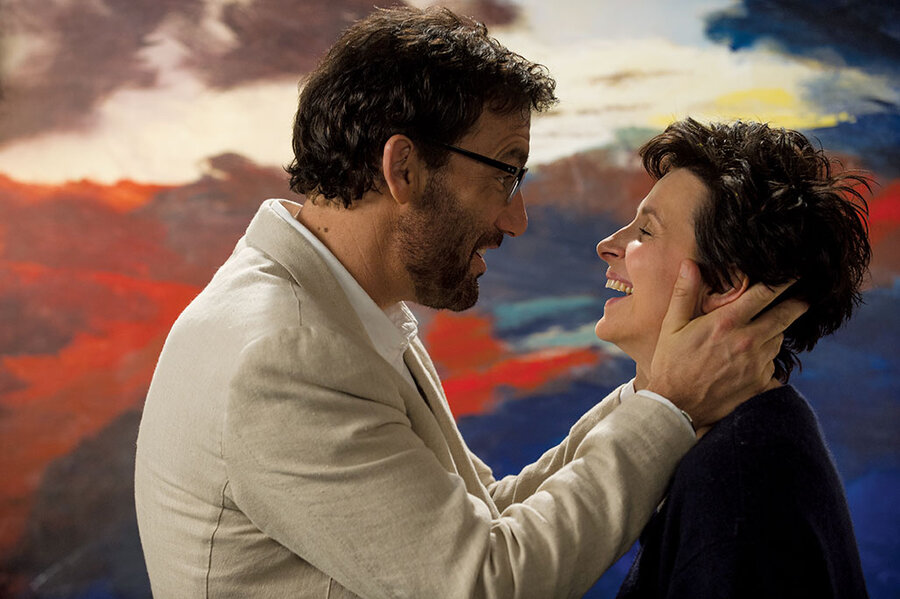'Words and Pictures': Actors Clive Owen and Juliette Binoche triumph over plot contrivances
Loading...
“Words and Pictures,” directed by Fred Schepisi, is a romantic comedy wrapped inside an intellectual skirmish. It literally tries to answer the question: Is a picture worth a thousand words?
In this corner, we have Jack Marcus (Clive Owen), an acclaimed alcoholic poet at a posh New England prep school. Jack has squandered his reputation and hasn’t written much of anything in years. Bored and bitter, he spews intricate word games to faculty and friends, who don’t bother to play along. He still loves literature, though, and bemoans the new generation’s obsession with pictures, screens, and images.
His opponent is the Italian-born Dina Delsanto (Juliette Binoche), the new art instructor, who is an abstract portraitist and a handful. (An accomplished artist, Binoche painted her own canvasses for the film.) One of the first things she tells her students is that she is “not the kind of teacher you’re going to come back to visit when you’re all grown up with a bunch of chocolates and a Hallmark card.” Her severe rheumatoid arthritis has made her own painting, her own life, a real challenge.
Rather too neatly, these two teachers square off from the get-go. Both acrid, both impassioned by their art, they seem made for each other – which, unlike us, takes them practically the entire movie to realize. It’s a sort of high I.Q. Tracy-Hepburn setup, though the chemistry between Binoche and Owen is often adulterated by a flurry of cooked-up contrivances. Screenwriter Gerald Di Pego’s writing is too diagrammatic and preachy, though he has a gift for tart one-liners. One of his best: Jack, introduced to the new art instructor and noting her artistically wrapped scarf, exclaims, “Hence the scarf,” to which Dina, noting his English lit credentials, shoots back, “Hence the hence.”
Jack and Dina’s nonstop arguing soon becomes the basis for a school-wide contest seeking to prove whether literature or painting is tops. If the preppies had been more sharply defined, less bland, this gambit might have paid off, but as it is, they don’t look like the kind of kids who would derive a great deal of inspiration from either words or pictures.
What keeps the film humming along pleasurably despite these stumbles is the high energy of the two leads.
Owen has been outfitted with a scraggly beard and nerdy glasses and well-worn corduroy jackets – read: intellectual – but he’s still a live wire even when he’s so obnoxious you would gratefully cede victory to the words people just to be done with it. Binoche, hobbling around with a walking stick, manages to make even infirmity seem sexy. She doesn’t play nice in this film. When Dina finally warms to Jack, the moment seems earned, not engineered.
I’m not sure why it’s so difficult in the movies to realistically portray a typical classroom situation. “Words and Pictures” does well enough, I suppose, in a watered-down “Dead Poets Society” kind of way, but it barely resembles what I (or I suspect many others in the audience) ever had to endure. Maybe the problem is that, like it or not, boredom is a huge element in the classroom, and most filmmakers feel the need to juice things up. More enjoyable for us perhaps, but not accurate. (The best school movie I’ve ever seen was the Fred Wiseman documentary “High School,” which brought it all back to me with a vengeance.)
“Words and Pictures” is a minor effort from Schepisi, but minor Schepisi still trumps most of what’s out there. He’s one of the world’s great directors, equally amazing at seething drama (“The Chant of Jimmie Blacksmith”) and transcendent romance (“Roxanne”). His film of the John Guare play “Six Degrees of Separation” is a model of theatrical adaptation. “The Russia House” is one of the most intelligent thrillers ever made; “A Cry in the Dark” is a great true-crime movie; “Barbarosa” is among the best, and most unheralded, of westerns. At his greatest, Schepisi cancels out any words versus pictures debate. His finest films are resplendent with imagery and language. Grade: B (Rated PG-13 for sexual material including nude sketches, language, and some mature thematic material.)





